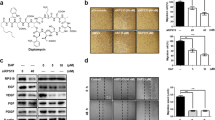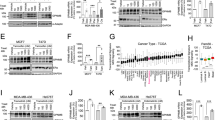Abstract
Induction of the urokinase-type plasminogen activator (uPA) by hepatocyte growth factor/scatter factor (HGF/SF) plays an important role in tumor cell invasion and metastasis that is mediated through the Met receptor tyrosine kinase. Geldanamycins (GA) are antitumor drugs that bind and inhibit HSP90 chaperone activity at nanomolar concentrations (nM-GAi) by preventing proper folding and functioning of certain oncoproteins. Previously, we have shown that a subset of GA derivatives exhibit exquisite potency, inhibiting HGF/SF-induced uPA-plasmin activation at femtomolar concentrations (fM-GAi) in canine MDCK cells. Here, we report that (1) inhibition of HGF/SF-induced uPA activity by fM-GAi is not uncommon, in that several human tumor glioblastoma cell lines (DBTRG, U373 and SNB19), as well as SK-LMS-1 human leiomyosarcoma cells are also sensitive to fM-GAi; (2) fM-GAi drugs only display inhibitory activity against HGF/SF-induced uPA activity (rather than basal activity) and only when the observed magnitude of uPA activity induction by HGF/SF is at least 1.5 times basal uPA activity; and (3) not only do fM-GAi derivatives strongly inhibit uPA activity but they also block MDCK cell scattering and in vitro invasion of human glioblastoma cells at similarly low drug concentrations. These effects of fM-GAi drugs on the Met-activated signaling pathway occur at concentrations well below those required to measurably affect Met expression or cell proliferation. We also examined the effect of Radicicol (RA), a drug with higher affinity than GA for HSP90. RA displays uPA activity inhibition at nanomolar levels, but not at lower concentrations, indicating that HSP90 is not likely the fM-GAi molecular target. Thus, we show that certain GA drugs (fM-GAi) in an HGF/SF-dependent manner block uPA-plasmin activation in tumor cells at femtomolar levels. This inhibition can also be observed in scattering and in vitro invasion assays. Our findings also provide strong circumstantial evidence for a novel non-HSP90 molecular target that is involved in HGF/SF-mediated tumor cell invasion.
This is a preview of subscription content, access via your institution
Access options
Subscribe to this journal
Receive 50 print issues and online access
$259.00 per year
only $5.18 per issue
Buy this article
- Purchase on Springer Link
- Instant access to full article PDF
Prices may be subject to local taxes which are calculated during checkout






Similar content being viewed by others
Abbreviations
- GA:
-
geldanamycin
- 17-ADG:
-
17-amino-17-demethoxygeldanamycin
- 17-AAG:
-
17-allylamino-17-demethoxygeldanamycin
- MA:
-
Macbecin II
- RA:
-
Radicicol
- fM-GAi:
-
GA and derivatives with uPA inhibitory activity in the femtomolar range
- nM-GAi:
-
GA and derivatives with uPA inhibitory activity in the nanomolar range
- HGF/SF:
-
hepatocyte growth factor/scatter factor
- uPA:
-
urokinase-type plasminogen activator
References
Bhattacharya A, Lakka SS, Mohanam S, Boyd D and Rao JS . (2001). Clin. Cancer Res., 7, 267–276.
Birchmeier C, Birchmeier W, Gherardi E and Vande Woude GF . (2003). Nat. Rev. Mol. Cell Biol., 4, 915–925.
Blagosklonny MV . (2002). Leukemia, 16, 455–462.
Bonvini P, An WG, Rosolen A, Nguyen P, Trepel J, Garcia de Herreros A, Dunach M and Neckers LM . (2001). Cancer Res., 61, 1671–1677.
Chavany C, Mimnaugh E, Miller P, Bitton R, Nguyen P, Trepel J, Whitesell L, Schnur R, Moyer J and Neckers L . (1996). J. Biol. Chem., 271, 4974–4977.
Duffy MJ . (1996). Clin. Cancer Res., 2, 613–618.
Duffy MJ, Duggan C, Maguire T, Mulcahy K, Elvin P, McDermott E, Fennelly JJ and O'Higgins N . (1996). Enzyme Protein, 49, 85–93.
Ellis V, Behrendt N and Dano K . (1993). Methods Enzymol., 223, 223–233.
Eustace BK, Sakurai T, Stewart JK, Yimlamai D, Unger C, Zehetmeier C, Lain B, Torella C, Henning SW, Beste G, Scroggins BT, Neckers L, Ilag LL and Jay DG . (2004). Nat. Cell Biol., 6, 507–514.
Gladson CL, Pijuan-Thompson V, Olman MA, Gillespie GY and Yacoub IZ . (1995). Am. J. Pathol., 146, 1150–1160.
Goetz MP, Toft DO, Ames MM and Erlichman C . (2003). Ann. Oncol., 14, 1169–1176.
Gondi CS, Lakka SS, Yanamandra N, Siddique K, Dinh DH, Olivero WC, Gujrati M and Rao JS . (2003). Oncogene, 22, 5967–5975.
Harbeck N, Kates RE, Look MP, Meijer-Van Gelder ME, Klijn JG, Kruger A, Kiechle M, Janicke F, Schmitt M and Foekens JA . (2002). Cancer Res., 62, 4617–4622.
Hattori N, Mizuno S, Yoshida Y, Chin K, Mishima M, Sisson TH, Simon RH, Nakamura T and Miyake M . (2004). Am. J. Pathol., 164, 1091–1098.
Jeffers M, Rong S and Vande Woude GF . (1996). Mol. Cell. Biol., 16, 1115–1125.
Koochekpour S, Jeffers M, Rulong S, Taylor G, Klineberg E, Hudson EA, Resau JH and Vande Woude GF . (1997). Cancer Res., 57, 5391–5398.
Lakka SS, Gondi CS, Yanamandra N, Dinh DH, Olivero WC, Gujrati M and Rao JS . (2003). Cancer Res., 63, 2454–2461.
Lee YB, Park MH and Folk JE . (1995). J. Med. Chem., 38, 3053–3061.
Liu ZG, Hsu H, Goeddel DV and Karin M . (1996). Cell, 87, 565–576.
Maulik G, Kijima T, Ma PC, Ghosh SK, Lin J, Shapiro GI, Schaefer E, Tibaldi E, Johnson BE and Salgia R . (2002a). Clin. Cancer Res., 8, 620–627.
Maulik G, Shrikhande A, Kijima T, Ma PC, Morrison PT and Salgia R . (2002b). Cytokine Growth Factor Rev., 13, 41–59.
Mimnaugh EG, Chavany C and Neckers L . (1996). J. Biol. Chem., 271, 22796–22801.
Nimmanapalli R, O'Bryan E and Bhalla K . (2001). Cancer Res., 61, 1799–1804.
Ochel HJ, Eichhorn K and Gademann G . (2001). Cell Stress Chaperones, 6, 105–112.
Rao JS . (2003). Nat. Rev. Cancer, 3, 489–501.
Roe SM, Prodromou C, O'Brien R, Ladbury JE, Piper PW and Pearl LH . (1999). J. Med. Chem., 42, 260–266.
Schneider C, Sepp-Lorenzino L, Nimmesgern E, Ouerfelli O, Danishefsky S, Rosen N and Hartl FU . (1996). Proc. Natl. Acad. Sci. USA, 93, 14536–14541.
Schulte TW, Akinaga S, Murakata T, Agatsuma T, Sugimoto S, Nakano H, Lee YS, Simen BB, Argon Y, Felts S, Toft DO, Neckers LM and Sharma SV . (1999). Mol. Endocrinol., 13, 1435–1448.
Schulte TW, An WG and Neckers LM . (1997). Biochem. Biophys. Res. Commun., 239, 655–659.
Schulte TW and Neckers LM . (1998). Cancer Chemother. Pharmacol., 42, 273–279.
Schweinitz A, Steinmetzer T, Banke IJ, Arlt M, Sturzebecher A, Schuster O, Geissler A, Giersiefen H, Zeslawska E, Jacob U, Kruger A and Sturzebecher J . (2004). J. Biol. Chem., 279, 33613–33622.
Solit DB, Zheng FF, Drobnjak M, Munster PN, Higgins B, Verbel D, Heller G, Tong W, Cordon-Cardo C, Agus DB, Scher HI and Rosen N . (2002). Clin. Cancer Res., 8, 986–993.
Stebbins CE, Russo AA, Schneider C, Rosen N, Hartl FU and Pavletich NP . (1997). Cell, 89, 239–250.
Tacchini L, Matteucci E, De Ponti C and Desiderio MA . (2003). Exp. Cell Res., 290, 391–401.
Tikhomirov O and Carpenter G . (2000). J. Biol. Chem., 275, 26625–26631.
Webb CP, Hose CD, Koochekpour S, Jeffers M, Oskarsson M, Sausville E, Monks A and Vande Woude GF . (2000). Cancer Res., 60, 342–349.
Whitesell L and Cook P . (1996). Mol. Endocrinol., 10, 705–712.
Whitesell L, Mimnaugh EG, De Costa B, Myers CE and Neckers LM . (1994). Proc. Natl. Acad. Sci. USA, 91, 8324–8328.
Yamamoto M, Sawaya R, Mohanam S, Bindal AK, Bruner JM, Oka K, Rao VH, Tomonaga M, Nicolson GL and Rao JS . (1994). Cancer Res., 54, 3656–3661.
Yang J, Yang JM, Iannone M, Shih WJ, Lin Y and Hait WN . (2001). Cancer Res., 61, 4010–4016.
Zhang X, Bu XY, Zhen HN, Fei Z, Zhang JN and Fu LA . (2000). J. Clin. Neurosci., 7, 116–119.
Acknowledgements
This study was supported by funding from the Robert J Lynch/American Brain Tumor Association Grant (to QX), a grant from the Michigan Life Sciences Corridor (GVW) and by the generosity of the Jay and Betty Van Andel Foundation. We appreciate Dr. Justi Rao providing us with U87 and SNB19 GBM cell lines. We are very grateful to Kyle Furge for helpful discussions and to Michelle Reed for assistance with the paper.
Author information
Authors and Affiliations
Rights and permissions
About this article
Cite this article
Xie, Q., Gao, CF., Shinomiya, N. et al. Geldanamycins exquisitely inhibit HGF/SF-mediated tumor cell invasion. Oncogene 24, 3697–3707 (2005). https://doi.org/10.1038/sj.onc.1208499
Received:
Revised:
Accepted:
Published:
Issue Date:
DOI: https://doi.org/10.1038/sj.onc.1208499
Keywords
This article is cited by
-
17-DMAG induces heat shock protein 90 functional impairment in human bladder cancer cells: knocking down the hallmark traits of malignancy
Tumor Biology (2016)
-
Comparative analysis of novel and conventional Hsp90 inhibitors on HIF activity and angiogenic potential in clear cell renal cell carcinoma: implications for clinical evaluation
BMC Cancer (2011)
-
17-Allylamino-17-demethoxygeldanamycin induces downregulation of critical Hsp90 protein clients and results in cell cycle arrest and apoptosis of human urinary bladder cancer cells
BMC Cancer (2010)
-
Inhibitor of Heat-shock Protein 90 Enhances the Antitumor Effect of DNA Vaccine Targeting Clients of Heat-shock Protein
Molecular Therapy (2007)
-
ARF6-dependent activation of ERK and Rac1 modulates epithelial tubule development
The EMBO Journal (2007)



